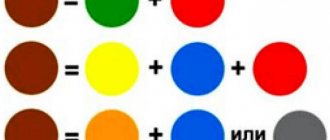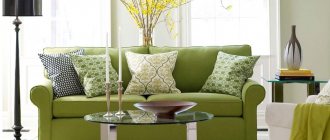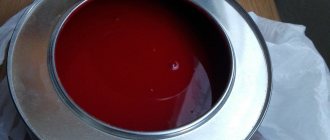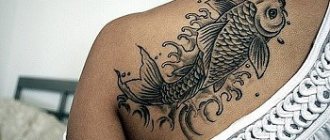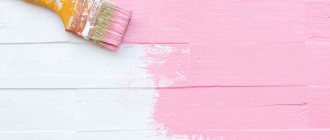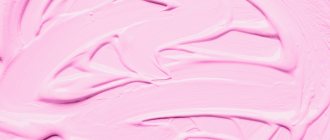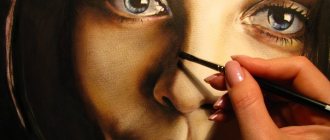Mint color is a nice combination of white, blue and yellow colors. It belongs to the pastel tone because this shade of green is muted and more delicate. It is often used by designers, confectioners and artists to make their work even more beautiful and rich. In this article we will learn how to get mint color, how it affects the mood and character of people, as well as what objects in nature have this shade.
How to get different colors by mixing paints
There are countless shades in nature.
Sometimes, in order to convey the plot most realistically, you need tones that cannot be found in the palette. But choosing them yourself, without sufficient experience, is quite difficult. A color mixing table greatly simplifies this process. It allows you to get the desired result, both in fine art and in construction, when creating an individual design solution in the interior.
If we talk about drawing, we need to remember that the overall appearance will be influenced not only by the exact ratio of paints, but also by the background, the orientation of the stroke in relation to the thread of the canvas, the thickness of the application and other points.
For convenience, we will divide the shades into groups of primary colors and tell you which paints should be used to obtain a particular tone of the required saturation.
How to choose a style
If it is important for you to decorate your interior in a modern design, then you need to choose the appropriate style. Marine style is often used in combination with menthol interiors
Other types of interior are possible
Marine style is often used in combination with menthol interiors. Other types of interior are also possible.
Classic style
It is used if the space is spacious and the ceiling is high. To paint the walls, choose a mint shade. It is permissible to use modeling, in some cases gilded. For ceilings - white, or the same tone as for the walls.
Living room furniture should have rich upholstery, and its color should be repeated in the curtains. Crystal decorations on lamps are desirable. Classic bedrooms are decorated more modestly. Upholstered furniture, curtains and walls are decorated with menthol shades.
Minimalist style
When decorating an interior in this style, use a maximum of three colors. Minimalism is appropriate in kitchen spaces.
Wall cabinets of simple shape are used. The apron is decorated with tiles with an ornament of geometric shapes.
Provence style
For the floor, use a wooden covering (laminate or parquet). It is permissible to supplement it with a rug - a mat. To paint the ceiling you need white.
The ceilings and walls are decorated with wooden clapboards, or a block house is used.
Sea style
The recommended color for the headset is pale gray. The tabletop can be gray with streaks of color with a mint shade of the body. Chairs are purchased with solid backs with marine-themed designs. Lighting fixtures are like anchors.
Easy mixing
Before we begin to describe complex shades, let's try to understand the basic ones. It is generally accepted that there are only three primary colors: red, yellow and blue. Based on them, secondary ones are obtained:
Orange
Red plus yellow;
Green
Yellow plus blue;
Violet
Blue plus red.
If we combine one primary and secondary color each, we will achieve transitional shades: red-orange; yellow-green; blue-violet; red-violet; blue-green and yellow-orange. Often these tones serve as the basis for obtaining realistic, deep and rich colors.
Blue
Happens quite often. You cannot do without it when creating the sky, ice, water, flowers and other elements.
The plausibility of the drawing depends on the slightest nuance; fortunately, mixing colors allows you to get the desired shade of blue:
Turquoise
Feel free to stir in green;
If it is turquoise, close to blue, add a little of the same green;
Pastel blue
Mix in white;
Wedgwood
Combine with white and a drop of black paint;
Dark blue (deep)
Add black and a little green to the base paint;
Royal blue
Even more black and a little green. Can be diluted a little with water;
Violet
Mix bright red paint;
Gray-blue
Light gray and a little white;
Light turquoise
Requires a blue-green base, to which yellow-green and white tones are mixed drop by drop;
Turquoise green
Add blue to green;
Dark turquoise
We get it by combining blue-green and yellow-green, adding the latter drop by drop;
White-blue
The main paint is white, and blue is already mixed into it;
Cornflower blue
It is obtained by mixing purple, a drop of red-brown, blue and black;
Lavender
Dilute purple and blue with water.
Bathroom
Using this color in the bathroom, you can give free rein to your imagination, because there is never too much mint in the bathroom. Using mint, close to turquoise, you can achieve a fabulous marine atmosphere. This color will help you relax and get maximum pleasure from water treatments. You can also focus on accessories and use towels, curtains and small bathroom accessories in this shade.
Original bathroom using blue and white tones
Mint will help enhance the illumination and spaciousness of the room
Grey
It is found in works and interiors at least blue. Many natural phenomena, shadows and unobtrusive wall coverings in the apartment are created using these neutral shades.
Regular gray
Black and white in equal quantities;
Black with a dash of white will make the gray darker. White and a little black - lighter.
Pearlescent gray
Mix two monochrome colors with blue;
Cool shade of gray
Mix gray with green;
Warm
Mix gray with ocher;
Gray-green
Mix white and green to gray;
Gray-blue
To the light gray add a white tone and blue pigment;
Charcoal gray
Mix a large amount of black pigment into the gray.
The working process
By mixing several different colors, you can get a large number of different shades. Which ones?
Shades of Gray
Quite often used in interior decoration. They help create shadow or unobtrusive color, as well as:
- You can create a regular gray by mixing black and white.
- To create cool shades, you need to add a little green to gray, and ocher for warm shades.
- Grey-green is gray with white and green.
- Gray-blue - gray, white and a little blue.
- Dark gray is the result of mixing gray and black.
Brown tones
To get a rich brown dye, you need to mix:
- green with red;
- red with blue and yellow;
- red with white, black and yellow.
How to create other original tones:
- You can get mustard if you add red, green and black dyes to yellow paint.
- Tobacco shade is red, green, yellow and white.
- Golden brown is the result of a combination of yellow, red, green, white and blue. In this case, there should be more yellow pigment.
- The basis for the pink shade is considered to be white. Red is added to it. The brighter the desired shade, the more red you should add.
- To get a rich chestnut color, you need to mix red and black.
- Bright red-orange color - red and a little yellow. The more of the latter, the paler the result will be.
- You can give the dye a purple tint by mixing a few drops of bright blue and yellow colors and red pigment.
- To create raspberry, according to the recipe, you need to mix bright red + white + brown + blue. The more white, the pinker the hue.
Red tones
- The basis for the pink shade is considered to be white. Red is added to it. The brighter the desired shade, the more red you should add.
- To get a rich chestnut color, you need to mix red and black.
- Bright red-orange color - red and a little yellow. The more of the latter, the paler the result will be.
- You can give the dye a purple tint by mixing a few drops of bright blue and yellow colors and red pigment.
- To create raspberry, according to the recipe, you need to mix bright red + white + brown + blue. The more white, the pinker the hue.
Green tones
Deep green color is formed by combining yellow and blue tones. The saturation of the finished dye depends on the amount of each of them. To create shades, you need to add other colors to green:
- For mint you will need white.
- To obtain an olive color you need green and a few drops of yellow.
- The shade of grass can be obtained by mixing green with blue. Yellow paint will help to even out the color.
- The color of the needles is the result of mixing green with black and yellow.
- Gradually mixing green with white and yellow, you can create an emerald tone.
Violet tones
Purple is made by mixing blue and red. You can also use blue and pink paints - the final color will be light, pastel. To darken the finished tone, artists use black paint, which is added in very small portions. Here are the nuances for creating shades of purple:
- for light purple, you can dilute the finished color with white in the required ratio;
- For purple, you need to add more red paint than blue.
Orange color
When creating classic orange, combine one part of yellow and red paint. But for many types of paint you have to use more yellow, otherwise the color will turn out too dark. Here are the main shades of orange and how to get them:
- for light orange use pink and yellow, you can also add a little white paint;
- for coral, dark orange, pink, and white are required in equal proportions;
- for peach you need colors such as orange, yellow, pink, white;
- for red, you need to take dark orange and a little brown.
Brown
Depending on what base color you need, combine:
- Green with red pigment;
- The same bright red shade with yellow and blue;
- Yellow paint with white, black and red;
- Mix orange with blue or gray.
Mustard
A yellow paint pigment combined with red, green and a small amount of black;
Golden brown
Lots of yellow and equal amounts of red, green, white and blue;
Medium brown
Add red and blue to yellow paint, lighten with white, and darken with black;
Basic Concepts
Before you start studying paint mixing tables, it’s worth familiarizing yourself with some definitions that will make it easy to understand a new material. The words used in the theory and practice of mixing shades are explained below. These are not scientific encyclopedic definitions, but transcripts in a language understandable to the average beginner, without the presence of complex terminology.
Achromatic colors are all intermediate shades between black and white, that is, gray. These paints contain only a tonal component (dark - light), and there is no “color” as such. Those where it is present are called chromatic.
Primary colors are red, blue, yellow. They cannot be obtained by mixing any other colors. Those that can are composite.
Saturation is a characteristic that distinguishes it from an achromatic shade that is identical in lightness. Next, let's look at what a table for mixing paints for painting is.
Mixing colors
Modern interior design is full of original shades. The range of finished products does not always contain the required halftone. The color mixing table will help you get the desired result at home. The information will be useful not only when renovating an apartment. Knowledge about mixing colors is useful to a wide range of people: novice painters, auto repair workers, decorators and other creative people.
Mixing experiments: what you need to know in advance
The world around us is filled with a wide color palette, but all the colorful splendor is based on three primary colors: blue, red and yellow. It is by mixing them that the desired halftone is achieved.
To get a new shade, use base colors in different proportions. The simplest example of how to get green. The answer is extremely simple: mixing yellow dye with blue. A visual table of primary, secondary and transition colors obtained by mixing is presented below:
This table will help you understand that the question of how to get yellow is in itself incorrect. It cannot be achieved by combining other components, since yellow belongs to three basic tones. Therefore, when the need for yellow arises, they purchase a ready-made dye or extract the pigment from natural products, which is not entirely advisable.
The same initial colors, taken in different proportions, when mixed, give a new result. The larger the volume of one dye, the closer the final result after mixing will be to the original shade.
Experiments must be carried out taking into account generally known rules. If you combine chromatic colors that are close to each other on the color wheel, after mixing you get a paint with a pronounced chromatic hue, although it does not have a pure tone. The combination of dyes located in opposite directions leads to the formation of an achromatic tone, in which a gray tint predominates. The chromatic circle will help you navigate the optimal combination of colors:
For example, if you take red cinnabar and lead white, the resulting bright pink color will darken after some time. It is advisable to take the most limited amount of original paints to obtain the desired tone. When mixing, their compatibility must be taken into account. For example, oil-based dyes are sensitive to solvents. It is better to immediately exclude materials that darken or quickly fade. A table of combinations that should not be used will prevent errors in the creative process:
Types of white paint
So, it is impossible to make white from other colors. On the other hand, whitewash is available in any art and construction salons. What does white color consist of? It contains a certain pigment that determines its properties:
- Lead white: contains lead oxide. It is quite toxic to the body. In this regard, paints with this pigment are not currently used. Paints based on lead salts are the ancestors of white color and were widely used until the nineteenth century
- Zinc White: Contains zinc oxide as a color-determining pigment. These paints, unlike lead white, are safe for the body. They mix well with other colors, forming delicate light and pure shades. It is for these purposes that artists and colorists use zinc white color.
- Titanium white: contains titanium dioxide. Like zinc, they are safe for the body and relevant for work. The main difference between titanium salts is their high covering power, which determined their use.
Zinc and titanium white in gouache
Variety of shades of red
Red consists of a trio of original colors that make up the base. Therefore, even a minimal set of paints cannot do without it. However, the question of how to get a red color when mixing paints sometimes still arises. This happens because magenta is involved in printing, so creative searches for how to get red are natural. Everything is solved extremely simply: to obtain natural red, yellow is mixed with magenta in 1:1 volumes.
The color scheme of red is diverse, so there are many combination options:
- An extremely popular question is how to get a crimson color. The initial colors for the mixture are red and blue in equal proportions; introducing small amounts of black or white color will help to vary the shade of crimson.
- There are several answers to how to get brown. The easiest way is to combine red and green. Since green itself is the result of mixing yellow and blue, then, accordingly, a combination of three primary colors will help to achieve a brown background. More detailed ways to achieve shades of brown are presented in the diagram:
- Pink can be obtained by combining red with white.
- If you mix 2 portions of red color with 1 part of yellow paint, you will get scarlet. To get orange, you need to increase the volume of yellow. Depending on the desired shade, orange is created by mixing pink paint and yellow dye.
- You can achieve burgundy in different ways. The easiest one is to add a drop of blue paint, because red itself is dark. A similar result will be obtained by introducing a little yellow and a drop of black paint into the red color.
- Mixing red and pink dye allows you to achieve a softened red undertone; white color will help increase the result.
- Combining red with violet in a 3:1 ratio results in a dark red tone.
The variety of shades of red is demonstrated by the next circle. It is worth noting that adding white colors to any mixture leads to lightening of the tone, and black ones to darkening.
The table below will help you understand the names of shades of red:
Ways to get classic color
The answer to the question of how to make a classic brown shade depends on the paints available. There are several mixing options:
- By combining red and green dye. Moreover, the use of dark red and dark green shades is unacceptable, otherwise a background close to black will be formed.
- If the existing paints do not contain a green element, mix blue with yellow and add red.
- Brown paint can be obtained by adding a gray or blue tint to the orange color.
- Those who want to experiment can be advised to mix yellow and purple colors. A violet tone is sometimes used as a substitute for purple.
Attention! The latter method requires particularly careful dosage. The slightest excess of the volume of mixed paints will result in an unnecessary shade.
Variations of blue
An equally rich palette of shades is obtained by mixing with blue dye, which is part of the basic triad. Therefore, its presence in any set is mandatory. However, even a set of 12 colors sometimes does not meet the needs for a true blue tone. The reason is color variations. The classic tone is called royal, and on sale it is often replaced by ultramarine, which is characterized by a bright dark shade with a slight presence of violet. Therefore, the question of how to get blue no longer seems absurd. The way out of this situation is to add white to the base color in a ratio of 3:1. Blue is obtained in the same way, only more white is used when combining.
What shades of crimson exist?
Raspberry is generally considered feminine, and by and large it is.
It is mainly used by women (in interiors, clothing, cosmetics, accessories, etc.); among men this tone is practically not in demand.
However, you should not overdo it with it, this will lead to rejection of the tone as such, and from an attractive shade it will turn into inappropriate absurdity.
What is an advantage and expands the scope of its use is that crimson is presented in a varied palette of tones (from bright and catchy, to pale and even dark).
The most sought-after and popular shades of crimson among consumers, designers and people of creative professions are:
- Geraldine.
- Indian red.
- Frez.
- Shades of coral.
- Dark pink.
- Cardinal.
- Carmine red.
- Alizarin.
Variety of green
The original green is usually presented in all sets; if the required dye is not available, there are no problems obtaining it. Pairing yellow with blue gives the desired green background. But any direction of creativity, be it painting, interior design or another option for decorating objects, requires a wide palette of green. The basic principle of all experiments is to change the proportions of the base colors; white or black dye is used to lighten or darken the background.
Next we will talk about mixing options and the results of the experiment:
- The combination of blue and yellow with a small addition of brown represents khaki. Green with a small amount of yellow forms olive.
- Traditional light green is the result of mixing green and white. Adding yellow or blue will help regulate warmth.
The circle demonstrates a variety of green colors. The base dye is located in the center, followed by the additional component, and then the result of mixing. The last circle is experiments of the resulting tone with the addition of white and black dye.
The next table will become an assistant when conducting experiments.
Nail polish “Liquid sand” mint marzipan color
Manufacturers of nail art technologies are constantly trying to introduce innovations; one of these relative innovations will be the “liquid sand” texture varnish. After drying, a “sugared” surface is formed on the nail, i.e. it contains “sand” crystals. After drying, the result is a semi-matte manicure with a slight shimmer.
Covering with “liquid sand” will be associated with some difficulties - uniform distribution of crystals over the nail plate, therefore it is recommended to cover in several thick layers - preferably three.
When applied with topcoats or topcoats, especially matte or glossy ones, roughness is lost.
Among the disadvantages of “liquid sand” varnish, one can highlight the presence of rough nails that can cling, resulting in chips and cracks. Due to the presence of shimmer in mint marzipan color, its removal can be somewhat difficult. Moreover, crystals can injure the nail.
Reviews about the varnish are contradictory.
Some young ladies speak extremely negatively about him:
- instead of mint, the bottle says green, not without charm, but green;
- the brush is too thin, although this may have its advantages, but not when coating with textured varnishes;
- pungent, unpleasant odor;
- after drying, the nails resemble “sandpaper”, but after ordinary household chores, they become smoother, and wearing “sand” on the nail plates becomes more comfortable.
Others leave rave reviews - interesting structure, deep and beautiful color. Even despite the need to cover your nails in several layers, the polish dries very quickly, so the entire manicure will take a minimum of time.
Ideas for manicure with mint polish
A nail design in shades of mint will be good, even if done in a monochromatic color scheme, but it has its own characteristics.
Mint color is included in the pastel range, and all varnishes in this group must be applied in at least two layers.
It can also be used when modeling nails with a French manicure, and this color is used as the main color base, or when modeling the free edge, combining mint varnish with uniform shades.
Mint manicure can also be combined with a multi-color palette - for example, a soft transition from one to another. You can achieve a particularly elegant result by decreasing the intensity of the tone from the beginning to the edge of the nail. Mint polish goes best with white polish.
Color combination with mint nail polish
Multi-colored manicure is gaining momentum in popularity, especially among young girls. Various coating techniques can create a bright, festive look, or allow you to create a manicure that will suit a young business lady.
To create the perfect image, you need to know which tones will perfectly harmonize with each other and which will not.
Therefore, every girl should use the rules of friendly shades:
- monochrome coating - shades that are in the same color range, for example, green with blue, lettuce, turquoise;
- contrasting combination – mint and black/white;
- Gray, pink, dark blue, beige, brown and orange will look perfect with mint.
Other shade combinations
The color kaleidoscope is not limited to combining basic dyes. For example, gray is often required. Different proportions of white and black pigment will give a wide achromatic palette.
How to get ivory color? The base color will be white, with ocher and dark brown gradually added in small portions. Ocher promotes the appearance of warm tones, increasing brown leads to a cold background.
Another table shows the many mixing options:
How to get black? By combining cyan, yellow and magenta. They are not always available, so three basic dyes will help. Combining green with red will also give some semblance of black, but it will not be pure.
Mint color: how to get it, mixing features and recommendations
Mint color is a nice combination of white, blue and yellow colors. It belongs to the pastel tone because this shade of green is muted and more delicate. It is often used by designers, confectioners and artists to make their work even more beautiful and rich. In this article we will learn how to get mint color, how it affects the mood and character of people, as well as what objects in nature have this shade.
Mint in the bedroom
Textile curtains and bed linen in the interior of a classic mint bedroom
The combination with white can be successfully used in the bedroom; moreover, such a solution can visually expand the space and make the room brighter.
Mint color combination in the interior
Mint color in the bedroom interior creates an atmosphere of peace, comfort and tranquility. A mint bedroom will please the eye, give you a good mood and pleasant dreams.
Mint color in the bedroom interior
Mint accents in the form of pillows and bedspreads in the bedroom interior create a cozy atmosphere
Mixing Tools
Before you learn how to get a mint color, you need to stock up on the necessary paints and supplies.
- First, grab some clean brushes and a glass of clean water.
- Second, prepare a palette for mixing paint. This will help you achieve the exact shade before using it. You will be surprised, but even pastry chefs and painters use the palette, and not just artists.
- Thirdly, prepare several paints (watercolor, gouache, confectionery dyes).
If you do not have experience in mixing colors, it will be difficult to achieve the desired shade the first time. Don't be upset under any circumstances. It is important to understand that all paints are different in composition and concentration, so it is almost impossible to know the exact proportions. Let's learn how to get mint color in several ways.
Mint hair photo
Are you looking for a way to freshen up your look? Do you want to change something, but don't know which direction to go? Change your hair color and make it so original. Mint hair is suitable for a look at any time of the year.
Mint color is pastel, but not soft
The mint color is pastel, but not soft. It adds energy and freshness, leaving you looking radiant and youthful. Mint hair for your look is like mint lemonade for your body . It's just a powerful and delicious dose of refreshment.
Such different shades
Mint color can be divided into several tones. It often includes shades: pang, light cyan, snowy (cold) mint, aquamarine, magical mint.
- Warm tone. If you want to know how to get a mint color when mixing paints, then you need to dilute blue paint with yellow paint in the palette until you get a rich green color. Then add a little blue paint, and, if necessary, dilute the resulting tone with white.
- Cold tone. How to get mint color – rich and bright? Take green paint, add a little blue to it, and then dilute it with an aquamarine shade.
Who is it suitable for?
Mint color is universal, so it is often chosen by both girls and boys. However, it is very important to combine such shades with other pastel colors. This will make your nature more romantic, gentle, sensitive and attentive.
This is interesting! Mint color was incredibly popular in the 50s and 90s. Now shades are coming back into our lives. All tones are more saturated and bright than the usual mint.
Another interesting fact: aqua is also reminiscent of mint shades, but there are significant differences between the tones. Shades such as celadon have greens and grays as base colors, while aquamarine shades contain greens and blues.
Mint color is unusually subtle and sensual. It creates a unique atmosphere and gives comfort in the home, makes any designer item pleasant and harmonious, and makes a confectionery product appetizing and refreshing. Thanks to this article, you learned how to get mint color from paints. You just need to experiment and don’t be afraid to add a little blue or white to get a unique and attractive shade.
Useful tips
If desired, you can use instead of the usual green color:
- Emerald shade.
- Forest green.
- Dark lemon green.
- Christmas tree color.
- Harlequin.
- Deep green.
It is also important to understand that no matter what base you use to create a mint color, you can get completely different results. For example, when using classic green paint with the addition of a blue tint, you can get the following tones: mountain meadow, Crayola green jungle, mint, Caribbean green.
And if you use white to lighten, you can get shades: magic mint, very light bluish green, sea green Crayola, moderate or rich aquamarine. Now you know how to get a mint color by mixing different paints.
Mint ombre on hair
If you're not ready for such a drastic change, or if all your mint hair doesn't suit you, opt for a mint ombre. The effect will be more subtle, but still expressive.
Mint ombre looks good on blonde and brown hair, as well as dark hair. This is a good option for any girl - it's a safe dose of madness.
Mint hair color will refresh your look in the summer heat!
Post Views: 627
coolka4k
- Hair colors
Peculiarities
Mint color calms and relaxes the body and spirit, which has a positive effect on your well-being. It is ideal for adding to the interior of rooms such as the living room, bedroom, hallway, children's room and bathroom, even the kitchen.
- The main feature of mint color is that it can be used in any quantity - the eyes do not get tired of such shades, on the contrary, they calm thoughts, relax the body, give harmony and comfort. It is often used to decorate rooms that face the south (sunny) side. In this case, mint color will be the best choice, since these shades give a feeling of coolness, no matter how much the sun shines through the window.
- Mint tones are self-sufficient on their own. They go well with various shades of beige and other light shades of brownish-gray, as well as golden colors (including orange). Mint matches well with lilac, pink, bright blue and black tones.
- Designers and fashion designers really like that this color gives everything a certain “airiness”. Thanks to this, all shades are regularly used in all seasons, because they combine with both a sunny day and frosty freshness.
- Why is mint color given special significance? Because it is light, delicate, a little cool, but at the same time reminiscent of summer. But it is important to understand that the mint color is not the same as the tone of the leaves of the plant of the same name. On the contrary, it is a combination of soft blue and light green shades.
- Since mint color has a beneficial effect on the psyche, calms people down, and gives them a sense of calm, it is important to choose softer, quieter and more subdued tones to match. All together will create a romantic image, will whisper about sensuality and tenderness.
The magical properties of mint - use in witchcraft and healing
People have long believed that many plants are endowed with supernatural qualities. Herbs such as chamomile, sage, raspberry, juniper and mint are endowed with a magical nature and are used not only when added to tea, but also for various rituals. The use of mint leaves and flowers helps to attract good luck, cure diseases and develop psychic skills.
Mint and its magical properties
To attract good luck before going to an important meeting, you need to eat a mint leaf.
This plant is one of the most powerful in magic and is considered divine. It is designed to help strengthen a person’s supernatural abilities and awaken the gift of clairvoyance. Mint leaves and color are used for the following purposes:
- raising money;
- cleansing the house of negative energy;
- improving quality of life;
- attracting love;
- healing of diseases;
- cleansing and healing the body;
- relief from pain;
- improving intuition during rituals;
- attracting good luck and success.
How is it used?
The flowers of the plant will stir up old feelings in a couple if they have faded.
Magic mint is used most often for love spells.
Since it is such a powerful plant that it does not require additional preparation of tinctures, decoctions and various rituals.
It is enough just to put a sprig of grass in your pocket when going on a date, and then brew tea from it for your chosen one. When feelings fade in the family, practitioners recommend putting mint color in the bedroom to revive passion.
The plant will help creative people in finding inspiration and new ideas.
Mint has a strong effect for various occult rites and magical rituals in the first summer month, therefore, to help in witchcraft, it is collected in early June, when it has the greatest power.
The properties of mint are not limited to just magical ones. The plant is considered an excellent antiseptic, anti-nausea and pain reliever. Used to treat various ailments, such as:
- hypertension;
- insomnia;
- increased gastric secretion;
- colitis;
- chronic fatigue syndrome;
- vegetative-vascular dystonia;
- heart rhythm disturbances.
What other types are used?
The smell of this plant will give a person strength for more productive work.
They use not just ordinary herbs, but also peppermint. This medicinal plant is most often used for magical rituals of healing and purification; it is complemented by various talismans, amulets, amulets and smoking mixtures.
The herb dilates the blood vessels of the heart, brain and bile ducts, affects the body as a relaxing, sedative, diaphoretic and anti-inflammatory agent. To speed up the healing of a sick person, their body is rubbed with mint decoction, and during epidemics of diseases they are burned in incense burners, fireplaces or stoves.
The mint aroma promotes productivity and increased creativity.
Traditional recipes with the plant
Since ancient times, people have used the magical properties of this herb to prepare the following remedies:
- An infusion to eliminate unreasonable anger. Pour 3 handfuls of dry leaves with 2 liters of boiling water. Let stand for 10 minutes and add a small piece of lemon. Drink during the day.
- Talisman to attract love. Hide a sprig of the plant in the bedroom.
- To always have money, you need to put the sheet in your wallet.
- To attract good luck. Rub a mint branch in your palms.
- Cleansing the house from evil spirits. Collect the leaves of a sprig of grass early in the morning on a full moon and place them anywhere in the apartment, starting from the front door.
- A remedy for sound sleep. Fill the bags with the plant and place them at the head of the bed.
- A magical bath that attracts good luck. Throw a handful of leaves, which are collected into the growing Moon, into the ready water for bathing.
- For a visionary dream. When going to bed, hide a mint leaf under your pillow.
Essential oil helps to get rid of extra pounds when inhaling its aroma before a meal.
Other interesting ways:
- Elixir from the evil eye. Brew mint leaves and sprinkle this liquid on the room or person affected by the spell.
- A product for rapid weight loss. Smell the essential oil before every meal.
- Treatment of gynecological pathologies. Apply the freshly picked plant to the pubic area.
- Prevention of insomnia. Sew grass into the pillow.
- Relief from stress. Add the brewed herb to the bath before taking it.
- Strengthening creativity. Pin a twig into your hair.
- Elevation of mood and a surge of strength. Drink mint tincture instead of morning tea.
- From nervous experiences. Chew the leaf before an important meeting or event.
Mint and love
Mint infusion is considered a love elixir, which has a better effect on men than on women.
Therefore, in order to achieve mutual feelings from a gentleman, when going on a first date, a girl needs to take a mint bath and take with her a small amount of grass leaves. And at any convenient moment, drop an arbitrary amount of infusion into the man’s drink.
If feelings in a married or loving couple begin to fade, then a bouquet of mint placed in the bedroom will help in returning the former passion.
Source: https://ProTalismany.ru/apotropey/rastenia/magicheskie-svoystva-myaty.html


